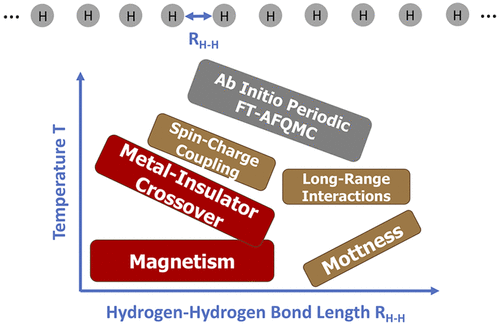当前位置:
X-MOL 学术
›
J. Chem. Theory Comput.
›
论文详情
Our official English website, www.x-mol.net, welcomes your
feedback! (Note: you will need to create a separate account there.)
Unveiling the Finite Temperature Physics of Hydrogen Chains via Auxiliary Field Quantum Monte Carlo.
Journal of Chemical Theory and Computation ( IF 5.7 ) Pub Date : 2020-05-26 , DOI: 10.1021/acs.jctc.0c00288 Yuan Liu 1 , Tong Shen 1 , Hang Zhang 2 , Brenda Rubenstein 1
Journal of Chemical Theory and Computation ( IF 5.7 ) Pub Date : 2020-05-26 , DOI: 10.1021/acs.jctc.0c00288 Yuan Liu 1 , Tong Shen 1 , Hang Zhang 2 , Brenda Rubenstein 1
Affiliation

|
The ability to accurately predict the finite temperature properties and phase diagrams of realistic quantum solids is central to uncovering new phases and engineering materials with novel properties ripe for device applications. Nonetheless, there remain comparatively few many-body techniques capable of elucidating the finite temperature physics of solids from first principles. In this work, we take a significant step toward developing such a technique by generalizing our previous, exact fully ab initio finite temperature Auxiliary Field Quantum Monte Carlo (FT-AFQMC) method to model periodic solids and employing it to uncover the finite temperature physics of periodic hydrogen chains. Our chains’ unit cells consist of 10 hydrogen atoms modeled in a minimal basis, and we sample 5 k-points from the first Brillouin zone to arrive at a supercell consisting of 50 orbitals and 50 electrons. Based upon our calculations of these chains’ many-body energies, free energies, entropies, heat capacities, double and natural occupancies, and charge and spin correlation functions, we outline their metal–insulator and magnetic ordering as a function of both H–H bond distance and temperature. At low temperatures approaching the ground state, we observe both metal–insulator and ferromagnetic–antiferromagnetic crossovers at bond lengths between 0.5 and 0.75 Å. We then demonstrate how this low-temperature ordering evolves into a metallic phase with decreasing magnetic order at higher temperatures. In order to contextualize our results, we compare the features we observe to those previously seen in one-dimensional, half-filled Hubbard models at finite temperature and in ground state hydrogen chains. Interestingly, we identify signatures of the Pomeranchuk effect in hydrogen chains for the first time and show that spin and charge excitations that typically arise at distinct temperatures in the Hubbard model are indistinguishably coupled in these systems. Beyond qualitatively revealing the many-body phase behavior of hydrogen chains in a numerically exact manner without invoking the phaseless approximation, our efforts shed light on the further theoretical developments that will be required to construct the phase diagrams of the more complex transition metal, lanthanide, and actinide solids of longstanding interest to physicists.
中文翻译:

通过辅助场量子蒙特卡洛揭示氢链的有限温度物理学。
准确预测现实量子固体的有限温度特性和相图的能力对于发现具有适用于设备应用的新颖特性的新相和工程材料至关重要。尽管如此,仍然很少有多体技术能够从第一原理中阐明固体的有限温度物理学。在这项工作中,我们通过概括我们以前的完全完全的从头开始,朝着开发这种技术迈出了重要的一步。有限温度辅助场量子蒙特卡罗(FT-AFQMC)方法对周期固体进行建模,并利用它来揭示周期氢链的有限温度物理学。我们的链的晶胞由最少模拟的10个氢原子组成,我们从第一个布里渊区采样5 k个点,以得到由50个轨道和50个电子组成的超级电池。根据我们对这些链的多体能,自由能,熵,热容量,双重和自然占有率以及电荷和自旋相关函数的计算,我们概述了它们的金属-绝缘体和磁有序是H–H的函数键距和温度。在接近基态的低温下,我们观察到键长度在0.5至0.75Å之间的金属-绝缘体和铁磁-反铁磁交叉。然后,我们演示了在高温下,这种低温有序过程是如何随着磁序下降而演变成金属相的。为了使我们的结果更加具体化,我们将观察到的特征与先前在有限温度和基态氢链中在一维半填充的Hubbard模型中观察到的特征进行了比较。有趣的是,我们首次确定了氢链中Pomeranchuk效应的特征,并表明在这些系统中,通常在Hubbard模型中不同温度下产生的自旋和电荷激发是难以区分的。除了在不调用无相近似的情况下以数值精确的方式定性地揭示氢链的多体相行为外,
更新日期:2020-07-14
中文翻译:

通过辅助场量子蒙特卡洛揭示氢链的有限温度物理学。
准确预测现实量子固体的有限温度特性和相图的能力对于发现具有适用于设备应用的新颖特性的新相和工程材料至关重要。尽管如此,仍然很少有多体技术能够从第一原理中阐明固体的有限温度物理学。在这项工作中,我们通过概括我们以前的完全完全的从头开始,朝着开发这种技术迈出了重要的一步。有限温度辅助场量子蒙特卡罗(FT-AFQMC)方法对周期固体进行建模,并利用它来揭示周期氢链的有限温度物理学。我们的链的晶胞由最少模拟的10个氢原子组成,我们从第一个布里渊区采样5 k个点,以得到由50个轨道和50个电子组成的超级电池。根据我们对这些链的多体能,自由能,熵,热容量,双重和自然占有率以及电荷和自旋相关函数的计算,我们概述了它们的金属-绝缘体和磁有序是H–H的函数键距和温度。在接近基态的低温下,我们观察到键长度在0.5至0.75Å之间的金属-绝缘体和铁磁-反铁磁交叉。然后,我们演示了在高温下,这种低温有序过程是如何随着磁序下降而演变成金属相的。为了使我们的结果更加具体化,我们将观察到的特征与先前在有限温度和基态氢链中在一维半填充的Hubbard模型中观察到的特征进行了比较。有趣的是,我们首次确定了氢链中Pomeranchuk效应的特征,并表明在这些系统中,通常在Hubbard模型中不同温度下产生的自旋和电荷激发是难以区分的。除了在不调用无相近似的情况下以数值精确的方式定性地揭示氢链的多体相行为外,











































 京公网安备 11010802027423号
京公网安备 11010802027423号